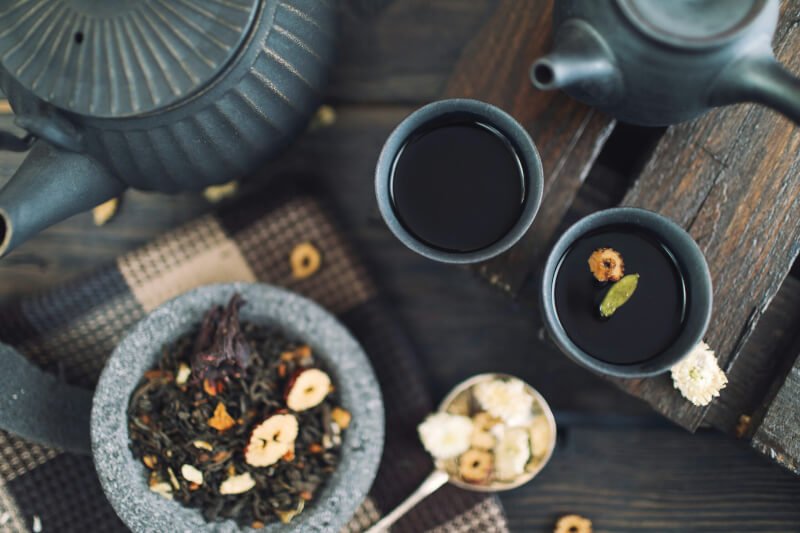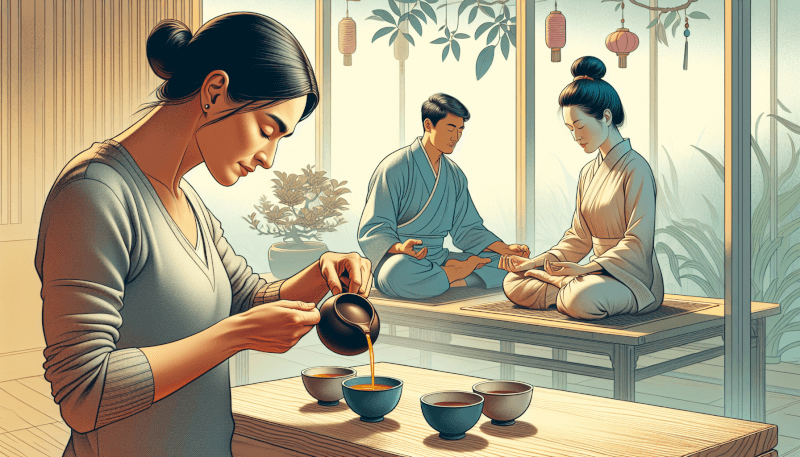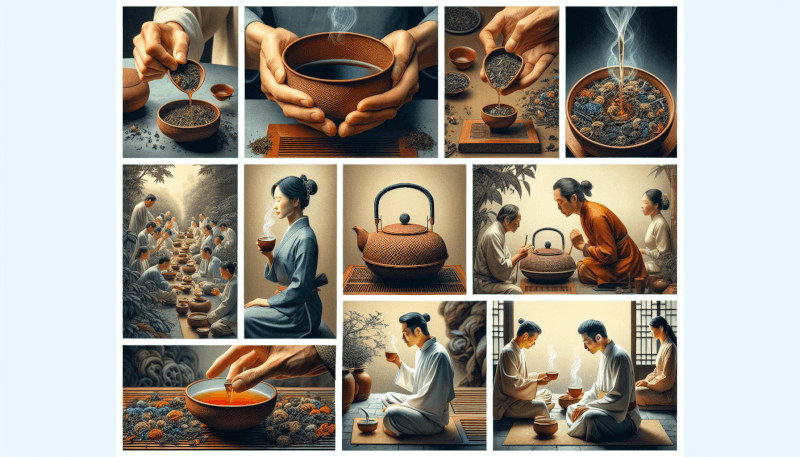Get ready to embark on a sensory journey like no other as we dive into the world of unique tea tasting techniques that will elevate your brewing experience to a whole new level. From the delicate aroma to the vibrant flavors, discover how to unlock the true essence of tea and savor every sip. Whether you’re an avid tea enthusiast or just starting your tea journey, these techniques will introduce you to a rich tapestry of flavors that will leave you craving more. So grab your favorite teacup, prepare to indulge your senses, and let’s explore the art of tea tasting together.

Understanding Tea Tasting
Tea tasting is an essential part of truly experiencing and appreciating the wide variety of teas available. By engaging in the practice of tea tasting, you can develop a deeper understanding of the flavors, aromas, and nuances that each tea possesses. Not only does tea tasting enhance your sensory experience, but it also allows you to make informed choices when selecting teas to enjoy on a regular basis.
The Importance of Tea Tasting
Tea tasting is crucial for a few key reasons. Firstly, it allows you to familiarize yourself with the characteristics of different teas, enabling you to choose teas that align with your preferences. Additionally, tea tasting helps refine your palate, allowing you to identify and appreciate the subtleties in flavor and aroma. This deeper understanding enhances the overall tea-drinking experience and opens up a whole new world of tea enjoyment.
Basic Steps for Tea Tasting
To effectively taste tea, there are a few basic steps to follow. First, ensure that you have a comfortable and quiet environment where you can focus on the tea. Begin by visually examining the dry leaves, taking note of their shape, color, and overall appearance. Next, inhale the aroma of the dry leaves to get a sense of the tea’s fragrance.
Afterward, it’s time to experience the infusion process. Steep the tea leaves according to the recommended brewing parameters, such as water temperature and steeping time. As the tea infuses, observe the color of the liquor and give it a quick sniff to capture its aroma. Finally, take small sips of the tea, focusing on the taste, mouthfeel, and aftertaste. Pay attention to any notable flavors or complexities that you detect, and consider how the tea makes you feel overall.
Developing a Tasting Palette
Before diving into tea tasting, it’s essential to develop your tasting palette. This involves training your palate to identify and differentiate between various flavors and aromas commonly found in teas.
Training Your Palate
Training your palate is an ongoing process that requires practice and exposure to a wide range of flavors. You can start by focusing on tasting different types of foods and beverages, such as fruits, spices, and herbs. Take note of the flavors you encounter and try to describe them in detail. With time, your palate will become more attuned to the complexities of taste, allowing you to better appreciate the nuances in teas.
Identifying Flavors
When tasting tea, it’s helpful to have a repertoire of flavors to reference. Some common flavor profiles found in teas include floral, fruity, nutty, grassy, and earthy. By familiarizing yourself with these flavors, you can narrow down the taste characteristics that appeal to you. It’s important to keep in mind that different teas can exhibit a wide range of flavor combinations, making each tea tasting experience unique.
Understanding Aromas
Aromas play a significant role in the overall tea tasting experience. The aromas emitted by tea leaves can be subtle, complex, and captivating. Take the time to inhale deeply and try to identify the various scents that arise from the dry leaves, infused liquor, and even the empty cup. Some common aromas found in teas include floral, fruity, herbal, and woody. Developing your ability to detect and appreciate these aromas will enhance your tea tasting journey.
Choosing the Right Tea
With a multitude of tea varieties available, choosing the right one can seem like a daunting task. However, armed with a basic understanding of tea types and factors to consider, you can confidently select teas that suit your preferences.
Exploring Different Tea Varieties
Tea comes in several varieties, each with its unique characteristics. Common tea types include green, black, oolong, white, and herbal teas. Green tea is known for its fresh and grassy flavor, while black tea often exhibits robust and bold characteristics. Oolong tea falls somewhere in between, offering a balance of flavors. White tea is delicate and subtle, while herbal teas are caffeine-free and offer a wide array of flavors from chamomile to peppermint. Exploring each variety will help you understand the nuances and complexities of teas.
Factors to Consider When Selecting Tea
When choosing tea, factors such as origin, processing methods, and quality should be taken into account. The region where the tea is grown can influence its flavor profile, as different climates and soil compositions produce varying results. The processing methods used also play a role in the final product, with techniques like oxidation impacting the taste and aroma of the tea. Lastly, consider the quality of the tea leaves. Look for reputable tea sources that prioritize freshness and sustainability for a truly enjoyable tea tasting experience.
Preparing Tea for Tasting
Properly preparing tea is crucial to experiencing its full range of flavors and aromas. Here are some essential considerations when preparing tea for tasting.
Proper Water Temperature
Different teas require specific water temperatures to ensure optimal taste. For example, green teas typically fare well with lower water temperatures around 160-180°F (71-82°C), while black teas may benefit from hotter water around 200-212°F (93-100°C). It’s essential to follow the recommended water temperature guidelines provided for each tea to achieve the best results.
Optimal Steeping Times
Steeping time also varies depending on the type of tea you are tasting. Generally, green teas require shorter steeping times of around 1-3 minutes, while black teas benefit from longer steeping times of 3-5 minutes. Oolong, white, and herbal teas fall somewhere in between, typically ranging from 2-4 minutes. Adhering to the suggested steeping times ensures that you extract the optimal flavors without overpowering or under-extracting the tea.
Teaware and Brewing Methods
Teaware selection and brewing methods can greatly impact the taste and overall tea tasting experience. Traditional options like clay teapots and gaiwans can provide a sense of authenticity and enhance the flavors of certain teas. Alternatively, modern brewing methods such as brewing baskets or infuser mugs offer convenience and ease of use. Experimenting with different teaware and brewing methods allows you to explore the nuances of each tea and find the approach that suits your preferences best.

The Art of Cupping
Cupping is a formalized method of tea tasting commonly used by professionals to evaluate and compare different teas. By understanding the cupping process, you can gain deeper insights into the teas you taste.
What is Cupping?
Cupping involves brewing and evaluating multiple teas side by side to assess their quality, characteristics, and nuances. Cupping is typically conducted using similar brewing parameters for each tea, allowing for fair and consistent evaluations. This method allows tea professionals and enthusiasts to compare the taste, aroma, and appearance of different teas and make informed judgments.
The Cupping Process
To conduct a cupping session, you will need several teacups, a tasting set, a kettle, and a timer. Start by carefully measuring and steeping the tea leaves in the teacups, adding hot water and following the appropriate steeping time. After the steeping time has elapsed, evaluate the tea’s appearance, noting the color of the liquor and the clarity of the infusion.
Next, assess the aroma of the tea by inhaling deeply from each cup. Pay attention to the intensity, complexity, and specific characteristics of the scent. Finally, taste the tea by taking small sips from each cup. Focus on the flavor, body, and aftertaste, considering the overall balance and quality. By following a consistent cupping process, you can establish a reliable method for evaluating teas.
Gaining Insights through Cupping
Cupping provides valuable insights into the sensory characteristics of different teas. By evaluating multiple teas side by side, you can identify the unique qualities and preferences that suit your taste. Cupping is an excellent way to discover new teas, explore flavor profiles, and ultimately enhance your tea tasting journey.
Exploring Traditional Tasting Techniques
Traditional tasting techniques offer a glimpse into the rich cultural heritage surrounding tea. These techniques not only allow you to taste tea but also provide a deeper understanding of the tea’s cultural significance.
Gongfu Cha
Gongfu Cha is a Chinese tea brewing technique that emphasizes multiple short infusions. This method allows the tea drinker to experience the various stages of flavor development as the leaves unfold. Gongfu Cha involves using small teapots, called Yixing teapots, and multiple tea cups to taste the tea and observe its evolution throughout each infusion. This traditional technique highlights the artistry and ritualistic nature of tea drinking in Chinese culture.
Japanese Tea Ceremony
The Japanese tea ceremony, also known as Chanoyu or Sado, is a highly ritualized tea-drinking practice. The ceremony involves the preparation and presentation of matcha, a powdered green tea. Participants engage in a time-honored process of whisking and serving the matcha, while also appreciating the tranquil ambiance and aesthetics associated with the ceremony. The Japanese tea ceremony offers a unique and meditative approach to tea tasting, emphasizing harmony, respect, and mindfulness.
Moroccan Mint Tea Ritual
In Morocco, tea holds great cultural importance, and the tea preparation process is elevated to an art form. The Moroccan Mint Tea Ritual involves brewing Moroccan green tea with fresh mint leaves in a teapot, sweetening it with sugar, and serving it in small glasses from an impressive height. The pouring process creates a frothy and aerated tea, ensuring a layered and aromatic drinking experience. This ritualistic approach to tea tasting allows participants to savor the refreshing flavors of the mint while immersing themselves in Moroccan culture.

Incorporating Modern Techniques
While traditional techniques offer a sense of cultural immersion, modern techniques can also enhance the tea tasting experience by introducing new flavors and methods.
Aerating Tea
Aerating tea involves exposing the tea to oxygen, enhancing its aroma and flavor. This can be done by pouring the tea back and forth between two vessels to create a cascade or by using specialized devices like tea aerators. Aeration can bring out hidden nuances, add complexity, and create a smoother mouthfeel.
Cold Brew
Cold brewing tea involves steeping tea leaves in cold or room temperature water for an extended period, typically overnight. This gentle brewing method extracts the flavors more slowly, resulting in a sweeter, smoother, and less astringent cup of tea. Cold brewing is particularly popular for green and herbal teas, allowing the natural flavors to shine without the bitterness that might occur with traditional brewing methods.
Tea Cocktails
Tea cocktails, also known as “teatinis” or “libation infusions,” offer a creative and innovative way to enjoy tea. By incorporating tea into cocktail recipes, you can infuse unique flavors and add depth to traditional beverages. From classics like the Earl Grey Martini to experimental concoctions featuring herbal teas or matcha, tea cocktails cater to both tea and cocktail enthusiasts, providing a delightful and unexpected experience.
Pairing Tea with Food
Pairing tea with food can elevate both the flavors of the tea and the culinary experience. Understanding flavor synergies and balancing tastes can enhance the enjoyment of both the tea and the accompanying dish.
Flavor Synergies
Certain teas and foods have complementary flavor profiles that can create a harmonious and delightful pairing. For example, delicate white teas pair well with light and citrusy desserts, while robust black teas can stand up to rich and chocolatey treats. Green teas often complement seafood or light salads, and oolong teas can enhance the flavors of fruits and cheeses. By experimenting with different tea and food combinations, you can discover unique flavor synergies.
Balancing and Complementing Tastes
When pairing tea with food, it’s essential to consider the balance of flavors. The intensity, sweetness, bitterness, and acidity of both the tea and the food should be complementary or contrasting in a pleasing manner. For example, a robust and tannic black tea can balance the richness of a fatty or savory dish. Conversely, a delicate and floral tea can provide a refreshing contrast to spicy or strongly flavored foods. By finding the right balance and complementing tastes, you can create a truly harmonious tea and food pairing.

Recording and Evaluating Tea Tasting Notes
Recording your tea tasting experiences through tasting notes can foster a deeper understanding and appreciation for the teas you encounter. By noting your observations, you can develop a comprehensive reference of your favorite teas and assist in future tea selections.
The Importance of Tasting Notes
Tasting notes capture the essence of a tea, serving as a personal record of your experience. They allow you to recall the details of specific teas, including the flavors, aromas, and impressions they left on you. Tasting notes form a valuable resource for future comparisons and aid in your journey of discovering new and exciting teas.
What to Include in Tasting Notes
When recording tasting notes, include details such as tea type, origin, brewing parameters, and steeping times. Describe the appearance, aroma, and flavor characteristics of the tea, noting any specific flavors, mouthfeel, and aftertaste. Additionally, record your overall impressions, including any emotional or sensory responses the tea evoked. By capturing these details, you can refer back to your tasting notes and recall the unique aspects of each tea.
Organizing Tea Tasting Events
Tea tasting events present an opportunity to share the joy of tea with others and create memorable experiences. Whether it’s an intimate gathering or a larger-scale event, careful planning can ensure an engaging and enjoyable tea tasting experience for all participants.
Creating a Tea Tasting Menu
When organizing a tea tasting event, curate a menu that showcases a variety of tea types and flavors. Consider offering a selection of green, black, oolong, white, and herbal teas to cater to different preferences and provide a well-rounded tasting experience. It’s also helpful to provide a brief description of each tea to guide participants and spark curiosity.
Engaging Participants
During the tea tasting event, encourage active involvement from participants. Share insights about each tea, discussing its origin, characteristics, and brewing recommendations. Create opportunities for participants to ask questions, share their thoughts and experiences, and engage in discussions. By fostering a collaborative and open atmosphere, participants can learn from one another and deepen their tea knowledge.
Tea Tasting Party Ideas
Tea tasting events can be tailored to suit various themes and preferences. Consider hosting a themed tea tasting party, such as a floral tea celebration or a global tea exploration. Another idea is to organize a blind taste test, challenging participants to identify different teas using their senses alone. For a more casual gathering, a tea and dessert pairing party can provide a delightful and indulgent experience. The possibilities are endless, and by incorporating creative ideas, you can make your tea tasting event truly memorable.
In conclusion, understanding tea tasting is an invaluable skill that allows you to fully appreciate the plethora of flavors, aromas, and nuances found in different teas. By developing your tasting palette, choosing the right tea, preparing it properly, and exploring various tasting techniques, you can embark on a journey of tea discovery and enhance your overall brewing experience. Don’t be afraid to push the boundaries by incorporating modern techniques, experimenting with tea and food pairings, and recording your tasting notes. And, if you’re feeling adventurous, consider organizing your very own tea tasting event to share your love for tea with others. Cheers to a better brewing experience through tea tasting!


